.gif)
Trot (horse gait)
Encyclopedia
The trot is a two-beat diagonal gait
of the horse
, where the diagonal pairs of legs move forward at the same time. There is a moment of suspension between each beat.
From the standpoint of the balance of the horse, the trot is a very stable gait, and the horse need not make major balancing motions with its head and neck. This is a common gait that the horse is worked in for dressage
, due to its many variations.
The speed of a regular working trot is averages 8 to 12 km/h (5 to 10 mph), up to 19 km/h (12 mph) in a horse driving trials
marathon. Harness racing
horses are considerably faster. Other variations, such as the "jog trot" used in western pleasure
competition, may be much slower.
Eadweard Muybridge
was the first to prove, by photography, in 1872, that there is a "moment of suspension" or "unsupported transit" during the trot gait.
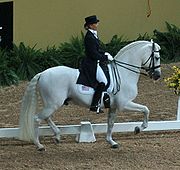
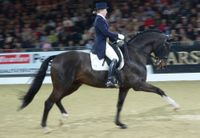
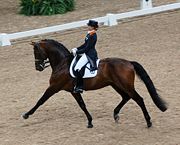 The trot can generally be classified as "working", "collected", or "extended", depending on the amount of engagement and collection of the horse. By the rhythm, one may distinguish a true, two-beat square trot, when each diagonal pair of hoofs hits the ground at the same moment, from a four-beat intermediate ambling
The trot can generally be classified as "working", "collected", or "extended", depending on the amount of engagement and collection of the horse. By the rhythm, one may distinguish a true, two-beat square trot, when each diagonal pair of hoofs hits the ground at the same moment, from a four-beat intermediate ambling
gait, such as the fox trot
or the "trocha" sometimes seen in the Paso Fino
.
Different speeds and types of trot are described with the following terms (from slowest to fastest):
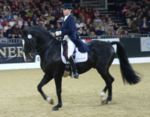
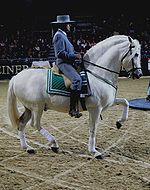 In advanced dressage, two additional forms of the trot are used:
In advanced dressage, two additional forms of the trot are used:
, such as those for the canter. When the rider is on the correct diagonal, the rider sits as the horse's inside hind leg and outside foreleg are on the ground, and rises as the outside hind leg and inside foreleg are on the ground. A rider can learn to recognize diagonals by feel. However, less-experienced riders discreetly check for the correct diagonal by a quick glance down, using peripheral vision
.
Horse gait
Horse gaits are the various ways in which a horse can move, either naturally or as a result of specialized training by humans.-Classification:...
of the horse
Horse
The horse is one of two extant subspecies of Equus ferus, or the wild horse. It is a single-hooved mammal belonging to the taxonomic family Equidae. The horse has evolved over the past 45 to 55 million years from a small multi-toed creature into the large, single-toed animal of today...
, where the diagonal pairs of legs move forward at the same time. There is a moment of suspension between each beat.
From the standpoint of the balance of the horse, the trot is a very stable gait, and the horse need not make major balancing motions with its head and neck. This is a common gait that the horse is worked in for dressage
Dressage
Dressage is a competitive equestrian sport, defined by the International Equestrian Federation as "the highest expression of horse training." Competitions are held at all levels from amateur to the World Equestrian Games...
, due to its many variations.
The speed of a regular working trot is averages 8 to 12 km/h (5 to 10 mph), up to 19 km/h (12 mph) in a horse driving trials
Combined driving
Combined driving also known as Horse Driving Trials is an equestrian sport involving carriage driving. In this discipline the driver sits on a vehicle drawn by a single horse, a pair or a team of four. The sport has three phases: Dressage, Cross-country Marathon and Obstacle Cone Driving and is...
marathon. Harness racing
Harness racing
Harness racing is a form of horse racing in which the horses race at a specific gait . They usually pull a two-wheeled cart called a sulky, although racing under saddle is also conducted in Europe.-Breeds:...
horses are considerably faster. Other variations, such as the "jog trot" used in western pleasure
Western Pleasure
Western Pleasure is a western style competition at horse shows that evaluates horses on manners and suitability of the horse for a relaxed but collected gait cadence and relatively slow speed of gait, along with calm and responsive disposition. The horse is to appear to be a "pleasure" to ride and...
competition, may be much slower.
Eadweard Muybridge
Eadweard Muybridge
Eadweard J. Muybridge was an English photographer who spent much of his life in the United States. He is known for his pioneering work on animal locomotion which used multiple cameras to capture motion, and his zoopraxiscope, a device for projecting motion pictures that pre-dated the flexible...
was the first to prove, by photography, in 1872, that there is a "moment of suspension" or "unsupported transit" during the trot gait.
Types of trot



Ambling
The term amble or ambling is used to describe a number of four-beat intermediate gaits of horses. All are faster than a walk but usually slower than a canter or gallop...
gait, such as the fox trot
Ambling
The term amble or ambling is used to describe a number of four-beat intermediate gaits of horses. All are faster than a walk but usually slower than a canter or gallop...
or the "trocha" sometimes seen in the Paso Fino
Paso Fino
The Paso Fino is a naturally gaited light horse breed dating back to horses imported to the Caribbean from Spain. Pasos are prized for their smooth, natural, four beat, lateral ambling gait and are used in many disciplines, but are especially popular for trail riding...
.
Different speeds and types of trot are described with the following terms (from slowest to fastest):
- Jog trot: seen in westernWestern ridingWestern riding is a style of horseback riding which evolved from the ranching and warfare traditions brought to the Americas by the Spanish Conquistadors, and both equipment and riding style evolved to meet the working needs of the cowboy in the American West...
horses, it is a slow, relaxed trot lacking the suspension of a working trot, with shorter strides. It is easy to ride because there is less "bounce." The head of the horse is carried low, and while the hindquarters are engaged and underneath the horse, there is less impulsion than in a dressage-style collected trot. http://western-undervisning.dk/images/ww_eli.jpg http://www.labeaucoosa.com/wpbeau1.jpg - Collected trot: a very engaged trot where most of the horse's weight is carried toward the hindquarters. The frame is compressed, the stride length is shorter than any of the other trots, with the horse taking higher steps. The horse is lighter and more mobile in the collected trot.http://www.classicaldressage.com/horses/images/merlin/merlin2004-248.jpg http://www.classicaldressage.net/members/images/L11trans2.jpg
- Slow trot (harness) or Road gait (roadster): slower than a working trot, but faster than a jog trot, this gait is one of the gaits used in [harnessDriving (horse)Driving, when applied to horses, ponies, mules, or donkeys, is a broad term for hitching equines to a wagon, carriage, cart, sleigh, or other horse-drawn vehicle by means of a harness and working them in this way...
classes at horse showHorse showA Horse show is a judged exhibition of horses and ponies. Many different horse breeds and equestrian disciplines hold competitions worldwide, from local to the international levels. Most horse shows run from one to three days, sometimes longer for major, all-breed events or national and...
s. - Working trot or Trot: the natural trot of the horse when under saddle. The stride length is "normal" for the horse (note: some breeds have naturally shorter or longer strides). It is a gait between the collected trot and medium trot. http://www.premierdressage.com/images/will_show_trot.JPG http://blythdale.tripod.com/sitebuildercontent/sitebuilderpictures/jennandstony.jpg
- Medium trot: a trot that is more engaged and rounder than the working trot, with moderately extended strides. It lies between the working and the extended trot. The horse has good, solid impulsion. http://www.bbmediaservices.com/images/samples/tanya-vinnie-medium-trot1-lg.jpg http://www.redstonehanoverians.co.uk/Medium%20Trot.jpg http://www.classicaldressage.com/horses/images/sedonna/sedonna2001-001.jpg
- Park trot: Sometimes simply called a Trot in a given class, seen in saddle seatSaddle seatSaddle Seat is a style of horseback riding within the category of English riding that is designed to show off the high trotting action of certain horse breeds. The style developed into its modern form in the United States, and is also seen in Canada and South Africa...
and fine harnessFine harnessFine harness is a type of driving competition seen at horse shows, that feature light, refined horses with high action. Popular breeds in this event include the American Saddlebred, Morgan, Arabian, Dutch Harness Horse, and Hackney ....
classes for Saddlebreds, ArabiansArabian horseThe Arabian or Arab horse is a breed of horse that originated on the Arabian Peninsula. With a distinctive head shape and high tail carriage, the Arabian is one of the most easily recognizable horse breeds in the world. It is also one of the oldest breeds, with archaeological evidence of horses...
and MorgansMorgan horseThe Morgan is one of the earliest horse breeds developed in the United States. Tracing back to the stallion Figure, later named Justin Morgan after his best-known owner, the breed excels in many disciplines, and is known for its versatility....
. It is a showy, flashy trot with extreme elevation of the knees (forearm is horizontal or higher and the hind legs are extremely flexed). The head is held high, and while at times a horse may hollow its back and lose cadence in an attempt to achieve high action in front, the hindquarters must be engaged for it to be properly performed. http://www.velocity.net/~prosper/Justice%20at%20Hamburg%202003.jpg http://www.sevenoaksstable.com/gallery/Customers/SirJames01_small.jpg http://www.ridgeviewstables.com/images/WingCommandersepia.jpg - Lengthened trot: a trot with lengthened strides. It differs from the more advanced extended trot in that is does not require the horse to bring its weight as far back on its hindquarters. http://www.cyberhorse.net.au/tve/showing/news/2005/vasl/450pics/hype7.jpg http://www.brookridgemorgans.com/LIZADRES3.GIF
- Road trot or Show at Speed: seen in roadster classes, this gait is similar to a racing trot, but much slower (suitable for an arena setting) the head is still collected. While the stride is still at maximum length, the step is still high and animated.
- Extended trot: an engaged trot with long strides, where the horse stretches its frame, lengthening the strides to the greatest degree possible. The horse has a great amount of suspension. The back is round and the horse's head just in front of the vertical. http://www.dressage.to/video_pages/olympicferro3_html, http://www.dressage.to/video_pages/londonderry_html.
- Racing trot: seen in harness racingHarness racingHarness racing is a form of horse racing in which the horses race at a specific gait . They usually pull a two-wheeled cart called a sulky, although racing under saddle is also conducted in Europe.-Breeds:...
horses that race at the trot, such as Standardbred. The stride is at its maximum length, with a great deal of suspension. The hind leg in a diagonal pair may begin to ground before the front. Unlike the extended trot, the neck is not round but extended out. http://personal.inet.fi/luonto/kaarne/galleria/ravit/3633.jpg http://www.le-cheval-bleu.com/aprhjulianocapucine.jpg http://www.le-cheval-bleu.com/aprh/olitro-viel05.jpg
Haute Ecole variations on the trot


- PassagePassage (dressage)The passage is a movement seen in upper-level dressage, in which the horse performs a highly elevated and extremely powerful trot. The horse is very collected and moves with great impulsion....
: a slow, elevated, extremely engaged and collected trot. The horse moves like it is in slow motion, with a long moment of suspension between steps. A very advanced movement. http://www.horsemagazine.com/CLINIC/D/DIERKS_CLEMENS/PROGRESSIVE_DRESSAGE/Passage.jpeg http://www.classicaldressage.com/horses/images/quarteto/quarteto2000-003.jpg http://www.horsemagazine.com/CLINIC/W/WILCOX_LISA/lisaandernsttwo/LISA/jerez.jpg - PiaffePiaffeThe piaffe[p] is a dressage movement where the horse is in a highly collected and cadenced trot, in place or nearly in place. The center of gravity of the horse should be more towards the hind end, with the hindquarters slightly lowered and great bending of the joints in the hind legs...
: an extremely collected trot in place, where the horse carries most of its weight on its hindquarters and does not move forward except for a few inches per stride at most. http://www.classicaldressage.com/horses/images/quarteto/quarteto2000-001.jpg http://www.expo.life.dial.pipex.com/Images/RichardDKarachiPiaffe.jpg http://www.neda.org/edu/images/Lisa_Wilcox.jpg
Riding the trot
There are three ways the trot may be ridden:- Sitting: The rider's seat remains in the saddle the whole time, following the motion of the horse, without bouncing. This is preferred for show ring western ridingWestern ridingWestern riding is a style of horseback riding which evolved from the ranching and warfare traditions brought to the Americas by the Spanish Conquistadors, and both equipment and riding style evolved to meet the working needs of the cowboy in the American West...
and in dressageDressageDressage is a competitive equestrian sport, defined by the International Equestrian Federation as "the highest expression of horse training." Competitions are held at all levels from amateur to the World Equestrian Games...
, especially at the upper levels. Sitting the trot gives the rider optimum control because he or she can use the seat and weight to influence the horse, asking for upward or downward transitions, turns, and to decrease or increase impulsion. It is also a test of equitationEquitationEquitation is the art or practice of horse riding or horsemanship.More specifically, equitation may refer to a rider's position while mounted, and encompass a rider's ability to ride correctly and with effective aids. In horse show competition, the rider, rather than the horse is evaluated...
, proving that the rider can quietly move with the horse. The jog, which is the preferred gait of western horses, is generally smoother and less-bouncy than the working and extended trot of the English-style horse.Sitting can be very tiring for the rider, especially if performed by riders who have not built up their stomach and back muscles, or if riders are on an extremely powerful mount with a big trot. To sit the trot, there is a slight forward and back movement of the lower back and stomach as the rider's hips follow both the up and down and side-to-side motion of the horse. To absorb the impact of the trot, the rider relaxes through the hips, the stomach and lower back, as well as the legs. The rider's upper body remains upright and quiet. The rider's hands remain steady. The lower legs remain relaxed and only come into play when the rider gives a leg aid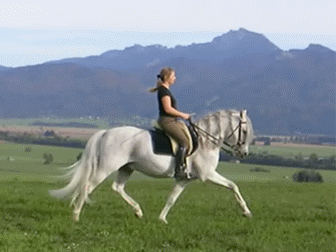 Riding aidsRiding aids are the cues a rider gives to a horse to communicate what they want the animal to do. Riding aids are broken into the natural aids and the artificial aids.-Natural aids:...
Riding aidsRiding aids are the cues a rider gives to a horse to communicate what they want the animal to do. Riding aids are broken into the natural aids and the artificial aids.-Natural aids:...
. If a rider cannot sit the trot and is bounced around, the rising trot is preferable, as not only is the rider uncomfortable, the constant slamming of the rider onto the horse is uncomfortable for the horse, who will hollow its back and stiffen its movement.
- Rising or Posting: The rider makes an up and down movement each stride, rising out of the saddle for one beat, and lowers (sits) for the second beat. When the rising trot is performed correctly, it is comfortable for the rider and easy on the horse. This is preferred for show jumpingShow jumpingShow jumping, also known as "stadium jumping," "open jumping," or "jumpers," is a member of a family of English riding equestrian events that also includes dressage, eventing, hunters, and equitation. Jumping classes commonly are seen at horse shows throughout the world, including the Olympics...
, hunt seatHunt seatHunt seat is terminology used in the United States and Canada to refer to a style of forward seat riding commonly found at American horse shows. Along with Dressage, it is one of the two classic forms of English riding. The Hunt seat is based on the tradition of fox hunting...
, eventingEventingEventing is an equestrian event comprising dressage, cross-country, and show jumping. This event has its roots in a comprehensive cavalry test requiring mastery of several types of riding...
(the jumping phases), saddle seatSaddle seatSaddle Seat is a style of horseback riding within the category of English riding that is designed to show off the high trotting action of certain horse breeds. The style developed into its modern form in the United States, and is also seen in Canada and South Africa...
, lower-level dressageDressageDressage is a competitive equestrian sport, defined by the International Equestrian Federation as "the highest expression of horse training." Competitions are held at all levels from amateur to the World Equestrian Games...
, and most other English-type riding as well as endurance ridingEndurance ridingEndurance riding is an equestrian sport based on controlled long-distance races. It is one of the international competitions recognized by the FEI. There are endurance rides worldwide....
. Although this does not provide as much control as sitting, it frees the horse's back. In the rising trot, the rider allows the horse's movement to throw his or her seat a bit out of the saddle. When coming back down, the seat touches down lightly rather than slamming down on the horse's back. Except in saddle seatSaddle seatSaddle Seat is a style of horseback riding within the category of English riding that is designed to show off the high trotting action of certain horse breeds. The style developed into its modern form in the United States, and is also seen in Canada and South Africa...
riding, rider's shoulders maintain a slight forward incline throughout the rising trot, instead of the upright, vertical position seen in sitting trot. The shoulders and lower legs remain in relatively the same position when the rider is both rising and sitting and the hands also stay in the same position as the rider rises and sits.
- Half-seat or Two-point: Variations are also called jumping positionJumping positionThe jumping position is a position used by equestrians when jumping over an obstacle. It usually involves what is known as the "forward seat" or "2 point" because the rider has 2 points in contact with the horse; the legs and hands. It was first developed by Captain Federico Caprilli...
, Half-seat involves the rider getting the seat bones off the saddle and keeping soft contact with the pelvis, two-point involves the rider raising the seat and pelvic bones. In both cases, the rider remains off the saddle and does not sit. This provides a great deal of freedom for the horse's back. It also offers the least amount of control for the rider. These positions are rarely used at the trot, although both are common at the canterCanterThe canter is a controlled, three-beat gait performed by a horse. It is a natural gait possessed by all horses, faster than most horses' trot but slower than the gallop, and is used by all riders. The speed of the canter varies between 16-27 km/h , depending on the length of the stride of the horse...
for jumpingJumping (horse)Jumping plays a major role in many equestrian sports, such as show jumping, fox hunting, steeplechasing, and eventing. The biomechanics of jumping, the influence of the rider, and the heritability of jumping prowess have all been the focus of research....
riders. Two-point also requires a good amount of strength in the rider's legs, which must be developed slowly.
Diagonals
A rider posts to one side or the other at the trot, called a "diagonal." Diagonals are used in the rising trot help to keep the horse balanced, and are also useful for timing certain riding aidsRiding aids
Riding aids are the cues a rider gives to a horse to communicate what they want the animal to do. Riding aids are broken into the natural aids and the artificial aids.-Natural aids:...
, such as those for the canter. When the rider is on the correct diagonal, the rider sits as the horse's inside hind leg and outside foreleg are on the ground, and rises as the outside hind leg and inside foreleg are on the ground. A rider can learn to recognize diagonals by feel. However, less-experienced riders discreetly check for the correct diagonal by a quick glance down, using peripheral vision
Peripheral vision
Peripheral vision is a part of vision that occurs outside the very center of gaze. There is a broad set of non-central points in the field of view that is included in the notion of peripheral vision...
.

